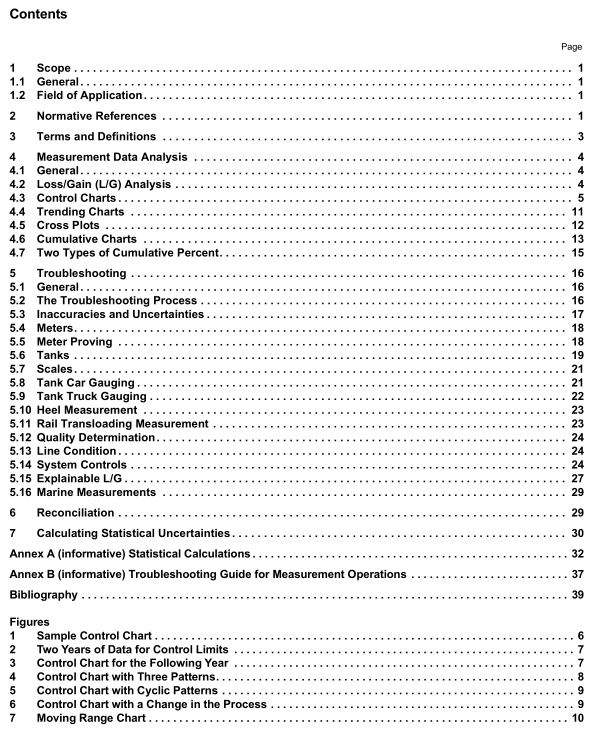API MPMS 23.2 pdf download

API MPMS 23.2 pdf download Manual of Petroleum Measurement Standards Chapter 23.2
3 Terms and Definitions
For the purposes of this document, the following terms and definitions apply.
3.1
action limits
Lines on a control chart that represent a boundary between taking or not taking action to modify a process.
3.2
central mean value
The average or standard value of the data being plotted on a control chart and is the reference value from which control limits are determined.
3.3
control chart
A graphical method for evaluating whether a process is in or out of a state of statistical control by using warning and action limits determined by statistical analysis of the process data.
3.4
control chart loss/gain (L/G)
A graphical method for evaluating whether L/G and/or meter proving operations are in or out of a “state of statistical control.”
3.5
control chart or log of fixed limit
A control chart or log whose control limits are based on adopted fixed values applicable to the statistical measurements displayed on the log or chart. Historically, fixed limits have been used to control the limits on meter factor changes.
3.6
control limits
Lines on a control chart used to evaluate whether or not a process is in statistical control.
3.7
repeatability
A measure of the agreement between the results of successive measurements of the same variable carried out by the same method, with the same instrument, at the same location, and within a short period of time.
3.8
standard deviation
The root mean square deviation of the observed value from the average.
3.9
statistical control
The data on a control chart are in a state of statistical control if the data hover in a random fashion around acentral mean value, and at least 99 % of the data are within the three standard deviation control limits, and thedata do not exhibit any trends with time.
3.10
systems tolerance limits
Control limits that define the extremes or conformance boundaries for variations to indicate when an audit ortechnical review of the facility design, operating variables, and/or computations may need to be conducted todetermine sources of errors and changes that may be required to reduce variations.Tolerance limits arenormally based on 99 % or greater confidence levels and are used interchangeably with upper and lowercontrol limits (UCLs and LCLs, respectively).
3.11
three standard deviation limit
A control limit equal to three standard deviations from the arithmetic mean of the set.
3.12
transloading
The transfer of a liquid hydrocarbon commodity from one bulk carrier to another bulk carrier where thequantity and quality transferred is measured via a measurement system.
3.13
warning limits
Lines on a control chart that represent a boundary between a predictable and unpredictable process.
4Measurement Data Analysis
4.1 General
Data may be presented in the form of control charts, trending charts, or cumulative charts. Guidelines on suchcharts may include control limits and trending lines. Charts used for monitoring measurement systems shouldbe living documents and should be updated whenever new data are availabie.Accumulating data for someperiod of time and periodically updating charts (e.g. semiannually) serves no useful purpose. Charts andmonitoring procedures can be effective only if charts are current and used as constructive tools.
4.2Loss/Gain (L/G)Analysis
LG is the difference between deliveries and receipts, adjusted for changes in inventory, experienced by asystem over a given time period (e.g. day, week, month) or over a single (or multiple) product movements.Losses may be physical (e.g. leaks,evaporation, theft, etc.) or apparent (e.g. errors in measurement, tickets,procedures,etc.). Gains may occur if unmeasured liquid is added to the system—higher than actual receipts.More often, there is no actual physical loss or gain, just simply small measurement inaccuracies or accountingdiscrepancies. The combination of these small measurement inaccuracies may result in a system beingoutside of normal or acceptable limits.
LG analysis typically involves collecting data, calculating L/G, and plotting LG on any of several differenttypes of charts. These charts may include control limits or other analytical guides that are derived from somesimple statistical tools. The tools described in this document may be used by anyone and do not require anunderstanding of statistics.
The terms ““overlshort” and “imbalance” are sometimes used interchangeably with “loss/gain.”









